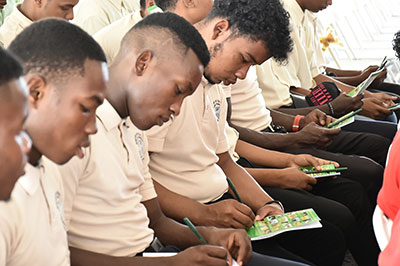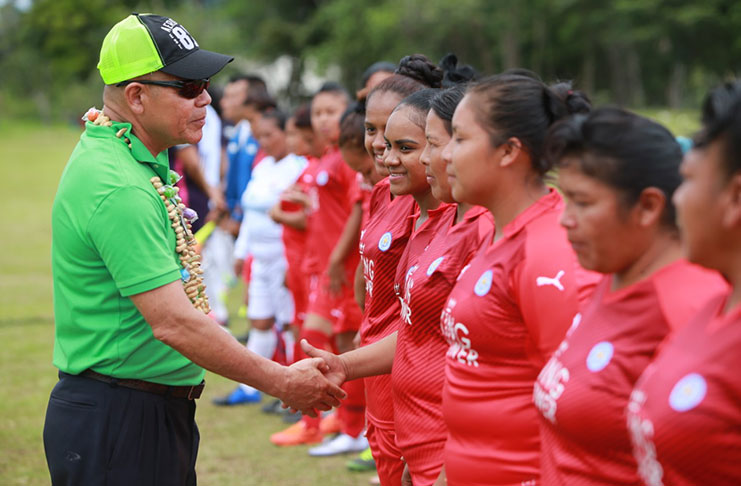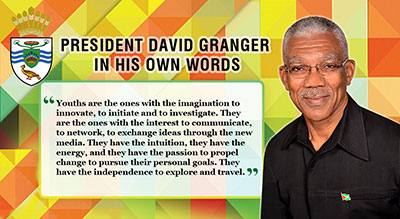–for the advancement of Social Cohesion
WITH Guyana’s Minister of Social Cohesion recently taking over the reins for Culture, Youth and Sport, it is not difficult to see the value of this change. Not only does it allow the Minister of Education to focus on the critical task of improving performance in that sector,

but it also helps to mainstream Culture, Youth and Sport as priority areas and vehicles for the advancement of Social Cohesion.
President David Granger, speaking during a fact-finding mission at the Cyril Potter College of Education (CPCE) in July, described culture as a cohesive force in any society; a force that helps diverse groups to understand the depths of each other’s belief systems, and to discover common ground.
“We have to understand each other better. You can do that through dance; you can do that through poetry; you can do that through drama, as you pointed out, but culture is a very important dimension,” the President said.
“You can’t leave religion out of culture; you can’t leave beliefs out of culture; faith out of culture. And again, I take the point that when we are looking at our education reform, these are considerations which have to be borne in mind,” he added.
Minister of Social Cohesion, Dr. George Norton — who has now received the baton to carry on the work started by Minister Nicolette Henry, who had held that portfolio since 2015 — recently spoke at the Harmony Festival 2017.

The objective of the Harmony Festival is to create an environment for greater understanding and appreciation of the country’s cultural and religious diversity.
Dr. Norton told his audience at the festival that culture is the backbone of the Guyanese society, and that its preservation is vital to the strengthening of a national identity. “It is, therefore, imperative that we carry on those cultural practices which were left by our forefathers instead of adapting [sic] the culture of other countries,” he said.
“Being neglectful of our culture will only lead to the erosion of our identity.”
Minister Henry, whose challenge it was to pull off the celebration of Guyana’s 50th Anniversary of Independence among other national events after inheriting a sector that had been allowed to wallow in mediocrity, noted that the creative industries can go beyond cultural expressions. She said Government is committed to building the capacity of creatives to become income generators.

“We definitely have to have more workshops, festivals and national competitions in 2018,” she said.
“And this will provide more opportunities, of course; particularly for persons in Literary Arts and Music, because, presently, there are only so many activities. And they are pretty much limited.
“We also have to educate creative people on diversification of their talents.”
THE FABRIC THAT UNITES
Director of Culture, Ms. Tomika Boatswain, who described culture as the fabric that unites people, noted that Guyanese culture stands out as distinctly different, even though there are some similarities when compared to other Caribbean states.
Given its importance to forging a national identity, Ms. Boatswain emphasised the need to provide more platforms for the growth and development of artists across the country.

She said, “For Visual Arts and Craft, we will be able to do more craft fairs; workshops where craft producers can understand how they can diversify their products.
“For example, a painter would need to know that there are other options he can use. For instance, he can use the very design to create fabric; to create screen-savers; to create book covers, for example. And you can earn from that.”
Ms Boatswain iterated that steps are being taken to ensure more visibility for artists, and that she is optimistic that with the inputs of stakeholders and members of society, Guyanese culture would be on show regionally and internationally, to the benefit of all.
Participation in activities such as the Caribbean Festival of Arts (CARIFESTA) puts our rich and unique culture on display for the Caribbean and other parts of the world. As such, the Director of Culture stressed the need for more involvement by local talents, as the department works towards improving the landscape.

The Guyana team was one of the most colourful and energetic during CARIFESTA XIII in Barbados. The Guyana booth, set up at the Grand Market, was a sight to behold, as the country’s rich culture and diversity was beautifully displayed for patrons to enjoy, and was admired by several Guyanese and foreigners alike.
Some of the country’s skilled steelpan players were also in attendance at the event, and performed exceptionally at the Christ Church Foundation School. The team entertained the audience with exuberant performances that brought the cheering crowd to its feet for standing ovations.
There were other cultural performances in the form of dance and drama, and our Visual Arts collection brought life to the rich Guyanese culture, drawing some of the largest crowds, with a total of 33 pieces depicting our Indigenous culture, our ethnic diversity, and the natural beauty of our Land of Many Waters.
Ms. Boatswain said, “We need to encourage more consumption in the local market, because I think that in itself adds value, and can engender more national pride, when you can say this piece is from a Guyanese artist and you have it on display in your home to feel proud. We need to get people more interested in supporting local.”
NATIONAL CULTURAL POLICY
A National Cultural Policy is imperative to attaining the goal of promulgating Guyanese culture. Guyana’s first and only completed initiative in creating a national cultural policy was written by former Director of Creative Writing in the Institute of Creative Arts, Mr A.J. Seymour, and published in 1977 with the support of UNESCO. Under the previous administration, little was done to advance this national cultural policy. However, since taking office in 2015, the Government, through the Department of Culture, has made significant progress, developing what is known as a Draft Framework National Cultural Policy.
 This cultural policy is divided into three broad areas: Mainstreaming Culture in Development; Cultural Heritage Preservation, Protection and Promotion; and Creative Arts and Cultural Industries Development.
This cultural policy is divided into three broad areas: Mainstreaming Culture in Development; Cultural Heritage Preservation, Protection and Promotion; and Creative Arts and Cultural Industries Development.
Cultural Policy Advisor, Mr. Ruel Johnson, said that the department is working to ensure that there is an updated copyright legislation, as well as a reformed Intellectual Property environment; something persons in the creative arts industry have been calling for.
Said he: “Within the framework of the CARIFORUM-EU EPA, one of the areas we are looking at is to assist countries within CARIFORUM, including Guyana, to create that sort of market intelligence infrastructure, so that we can properly assess how is it that our people consume creative products etc…
“Then, from them, we can look at market promotion, not just locally and regionally.”
There is a push for the development of a Creative and Cultural Arts Registry to better integrate information for the creation of a marketing strategy to advance the industry. An important aspect, also, is cultural preservation, which requires the collaboration of several ministries, such as the Ministry of Tourism, along with the Department of Culture. The first step involves the implementation of a multi-year process of restoration of 50 works at the National Art Gallery, with support from the Argentine embassy.
As Mr. Johnson noted, “Within that process as well, we are looking at developing technical capacity for restoration overall. “There is going to be an transfer-of-knowledge component of it, and then there are other ongoing initiatives that fall under the aegis of the National Trust, National archives and the museums.
“But certainly in the past two years and going forward, the National Trust has upped the ante in its preservation efforts.”
Important, too, is the protection of national artefacts from being smuggled out of the country, and heritage buildings from being transferred to private owners. One of the most notable achievements was the commencement of the digitalising of the information stored at all museums and archives. This will enable better storage and retrieval of information, while at the same time making the information more readily available to the public.
YOUTH EMPOWERMENT
Education is the single most important foundation for ensuring a generation of young people capable of seizing the reins of power, and tackling the country’s developmental challenges to take Guyana forward as a ‘green’ state; a state that is technologically advanced and able to develop its resources for economic prosperity.
But Guyana must still tackle, head-on, the challenge of improving the capacity of out- of-school youth to become earners and income generators, reducing the probability of at-risk youth becoming involved in social ills, and providing them with the opportunities to live ‘a good life’. At this level, education is still the answer.
President Granger has, on many occasions, said that his government is offering Guyana’s youth the opportunity to live productive lives through its investment in education. During a fact-finding mission to the Kuru Kuru Training Centre (KKTC), aimed at improving the performance of the centre to ensure it is meeting the needs of its target group and the developmental needs of the country, the Head of State said young people must first understand the importance of education to their upward mobility potential.
“When you get a job, you could produce; you can earn a living; you can earn a salary; you could produce goods and commodities which could be sold,” President Granger said, adding:
“If you are running an Internet Café, you could provide services. Once you’re employed, there is that dignity; that self-esteem that you can earn your living. You don’t have to beg mommy and daddy for money. You can have a house, a car; you can raise a family. So, employment is important to your self-esteem; it’s important to your survival.”
Minister Norton has indicated that youth development is going to be a major priority of his, as he looks to advance the work done by Minister Henry.
Said he: “I would particularly want to work much more closely with the youths, because we know how they cannot only influence the rest of the society, but particularly other youths.
“Also, youths are mostly interested in sporting activities, which we plan to use to motivate them; to get them involved in a productive manner.”
Youth empowerment has long been on the front burner for the Government of Guyana, and one of its most significant achievements was the adoption, by the National Assembly, of the long-awaited National Youth Policy in June 2016.
Government envisions that this policy will create the strategic framework necessary for the development of Guyana’s youth. The policy provides five strategic areas, namely: Youth identity and empowerment; youth employment and entrepreneurship; education and market-driven skills development; and youth leadership, participation and representation.
NATIONAL YOUTH POLICY
To Presidential Advisor on Youth
Empowerment, Mr. Aubrey Norton, youth development is a process; and because it has been recognised that young people are most vulnerable between the ages of eight and 14, the National Youth Policy, therefore, is crafted to find solutions to the problems they face at an early stage.
Mr Norton, while speaking in November 2016 at the closing ceremony of a Literacy and Numeracy Training Programme held at the Madewini Training Centre, said that what he has found, having traversed the length and breadth of the country, is that the problem with many of today’s youths is that they are school dropouts.
He said that it is based on those findings that the government has endeavoured to find ways of empowering them to become productive citizens of Guyana.
According to Mr. Norton, who has arranged several skills and youth empowerment training programmes:
“It is in that context that this programme was developed, so that we could involve those young people, and then put the mechanisms in place for them to upgrade, so that they can have the required certification to proceed as teachers or to any other field they want.”
Director of Youth, Ms. Melissa Carmichael, said the department is in the process of developing a Youth Empowerment Action Plan, which will ensure that what is stated in the National Youth Policy is put in place. She outlined several initiatives that the department has undertaken that have provided employment opportunities for the nation’s youth in all 10 administrative regions.
“We had the opportunity to collaborate with the Ministry of Public Security, where we had approximately 90 young people trained. And they were given grants to start up their own businesses,” she said, adding:
“We also had our recreational youth camps, where young people were exposed to a number of areas: Animation, life skills, designing, arts, life planning, family planning, civic education.
“We would have sensitised our young people through health fairs, which we had in collaboration with the Ministry of Health and other organisations.”
As it relates to capacity building, the Department was able to successfully host Community Skills Training Programmes across the regions, in the areas of Cosmetology, Information Technology, Plumbing and Leadership, among other disciplines.
Job Readiness Training and other Skills Training Programmes were also conducted, based on the needs of the respective communities. Four hundred and twenty two young people benefitted from the Youth Entrepreneurial and Skills Training (YEST) programme, and graduated from the Kuru Kuru, Sophia and Vryman’s Irven Training Centres.
According to Ms Carmichael, the programme has been certified through the Council for Technical, Vocational and Education Training; which makes the youths eligible for employment in their respective fields. Ms. Carmichael said these programmes have empowered hundreds of young people.
YOUTH WEEK ACTIVITIES
Additionally, Youth Week activities were held in Pomeroon-Supenaam (Region Two), Demerara-Mahaica (Region Four), East Berbice-Corentyne (Region Six), Cuyuni-Mazaruni (Region Seven) and Upper Demerara-Upper Berbice (Region 10), and proposals were assessed and approved for the Youth Innovation Project.
Another programme that has been making waves across Guyana by building a corps of competent, well-rounded youths with a love for their country is the President’s Youth Award Republic of Guyana (PYARG) scheme. Executive Director, Mr. Allister Collins said the programme continues to bear fruit, with Guyana being voted in as Secretary of the Caribbean Awards Sub-regional Council (CASC). The aim of the CASC is to foster cultural integration, and build capacity of awarded youth in the Americas region.
Given the opportunity for growth, Mr. Collins said the programme is available to youths all across the country, who are being urged to join it.
“Within the Department of Youth, we have the volunteer support platform,” he said. “And what we have been doing is collecting information from the general public on vacancies and job opportunities, and we have been referring young people to the various organisations, based on the list coming in.”
The community service component of the Programme, Mr Collins said, allows the youths to give back to their communities by developing small projects, such as clean-up campaigns, assistance for the village elders, tutoring and mentorship initiatives among others.
The expedition aspect takes participants all across the country to have a first-hand look of Guyana’s natural beauty, and with Government’s push for a ‘green state’, they are now taught how to protect the environment for future generations.
Thus far, 48 youths have been nominated for the award.
PRIORITISING SPORT
Guyana is on the path to rapid development in sport with the implementation of several programmes geared at improving sporting facilities and creating opportunities for all athletes, regardless of geographic location.
After a stellar performance at this year’s Caribbean Free Trade Association (CARIFTA) games in Curaçao, Team Guyana met with President Granger at State House, where the Head of State highlighted his Administration’s policy of having a broad base to produce quality athletes, with emphasis on grassroot sports.
The Head of State said, “The role of sports is very important, particularly for young people, and I always compared track and field with what happens in what used to be regarded as our primary school cricket.
“The only reason Guyana was able to rise so high in cricket, and produce international greats; you know, the Kanhais and the Lloyds, was because it had a broad base.
“So, by the time you reach the top, you really had people of excellence. But when sports have a very small, a very narrow base, you find that you do not get people consistently of international standard.
“And I would like to endorse the words of Christopher Jones, and express our government’s commitment to ensuring that there’s more grassroots sport in the schools and in the communities.”
Guyana finished the three-day CARIFTA Games with a total of eight medals: Four golds, one silver and three bronze.
It was the first time in the history of the event, which started in 1972, that a Guyanese won the male 100m, an event that’s usually dominated by the Jamaicans. Compton Caesar secured a gold medal in the 100 metres, and a bronze in the 200-metre races. Chantoba Bright copped gold in the long jump, and a bronze in the triple jump.
Claudrice McKoy also grabbed gold in the long jump, and a bronze in the triple jump. Natricia Hooper secured a gold medal in the triple jump, while Anfernee Headecker got silver in the 1500-metre race.
Director of Sport, Mr. Christopher Jones, speaking recently with Government in Action, said that the Sport Department has embarked on an ambitious plan in 2017, which will see both patrons and players benefitting from more adequate facilities during games.
“That would be the setting down of the two synthetic tracks in Regions 10 and Six; the upgrades to the National Gymnasium, which will see a multi-purpose court as well as a lawn tennis court being placed there to enhance the facility; the ambience inside,” he said, adding:
“We will also be installing cooling systems. And, in keeping with the Government’s vision of ensuring equitable distribution of resources and equal access to quality facilities for all Guyanese, officials of the NSC have been very busy over the past few months, travelling to various locations and identifying sport grounds that require upgrades.”
GROUND ENHANCEMENT FUND
Those grounds that have been identified, he said, will be upgraded through the Ground Enhancement Fund.
The “Light It Up” project will complement the Ground Enhancement initiative, and will see floodlights being installed at sporting grounds in eight regions, thereby allowing the athletes to train beyond sundown. Further, Mr. Jones said work is still ongoing in relation to the National Sport Policy, which will essentially guide the process of sport development in Guyana.
The first of the consultations with sporting associations and sportsmen and women began in July, and the Sport Director said their input is vital to advancing the process, as Government has placed a high value on stakeholders’ involvement.
More importantly, Mr. Jones highlighted the link between sport and youth development and how the two work together in moulding the nation’s youth into becoming productive members of society.
Additionally, the Sport Department has been working behind the scenes to empower youths by providing them with the opportunity to learn life skills through several training programmes being conducted in Demerara-Mahaica (Region Four), Mahaica-Berbice (Region Five), East Berbice-Corentyne (Region Six) and Upper Demerara-Upper Berbice (Region 10).



.jpg)











